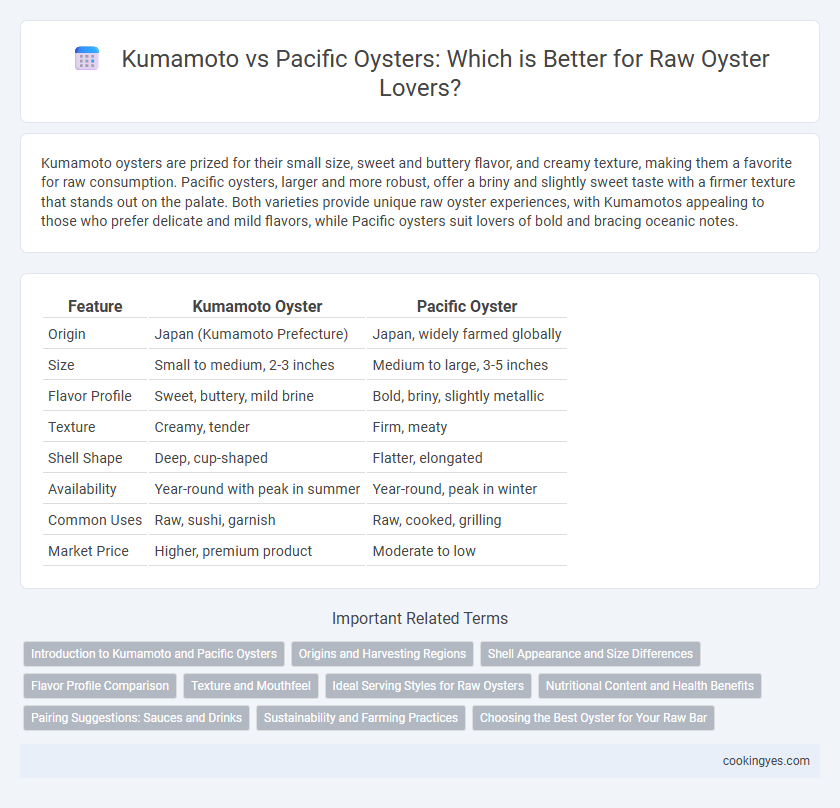Kumamoto oysters are prized for their small size, sweet and buttery flavor, and creamy texture, making them a favorite for raw consumption. Pacific oysters, larger and more robust, offer a briny and slightly sweet taste with a firmer texture that stands out on the palate. Both varieties provide unique raw oyster experiences, with Kumamotos appealing to those who prefer delicate and mild flavors, while Pacific oysters suit lovers of bold and bracing oceanic notes.
Table of Comparison
| Feature | Kumamoto Oyster | Pacific Oyster |
|---|---|---|
| Origin | Japan (Kumamoto Prefecture) | Japan, widely farmed globally |
| Size | Small to medium, 2-3 inches | Medium to large, 3-5 inches |
| Flavor Profile | Sweet, buttery, mild brine | Bold, briny, slightly metallic |
| Texture | Creamy, tender | Firm, meaty |
| Shell Shape | Deep, cup-shaped | Flatter, elongated |
| Availability | Year-round with peak in summer | Year-round, peak in winter |
| Common Uses | Raw, sushi, garnish | Raw, cooked, grilling |
| Market Price | Higher, premium product | Moderate to low |
Introduction to Kumamoto and Pacific Oysters
Kumamoto oysters, known for their small size, deep cup, and sweet, mild flavor, originate from the Pacific coasts of Japan and the West Coast of the United States. Pacific oysters, or Crassostrea gigas, are larger, more robust, and widely farmed globally due to their adaptability and briny, slightly sweet taste. Kumamoto oysters are prized for their creamy texture and unique fruitiness, while Pacific oysters offer a meatier bite and broader availability in raw oyster markets.
Origins and Harvesting Regions
Kumamoto oysters originate from the west coast of the United States, primarily harvested in the Pacific Northwest, known for their small size and sweet, mild flavor. Pacific oysters, also called Japanese oysters, are native to the coastal waters of Japan but are now extensively farmed along both the west coast of North America and various global regions, thriving in cooler, nutrient-rich waters. The distinct harvesting regions influence the oysters' brininess and texture, with Kumamotos favored for their creamy consistency and Pacific oysters for their bold, robust taste.
Shell Appearance and Size Differences
Kumamoto oysters feature deep cups with fluted, rough edges and a smaller, more compact size averaging around 2 to 3 inches, favored for their shell's rugged texture and unique shape. Pacific oysters are typically larger, growing up to 5 inches, with a broader, more elongated shell that is smoother and less ornate compared to Kumamoto. The distinct shell appearance and size differences between Kumamoto and Pacific oysters are key identifiers for consumers and chefs selecting raw oysters for their visual appeal and serving preferences.
Flavor Profile Comparison
Kumamoto oysters deliver a creamy texture with sweet, nutty undertones and a hint of melon, prized for their mild brininess and smooth finish. Pacific oysters present a more robust, briny flavor with a crisp, mineral edge and subtle cucumber notes, offering a sharper oceanic taste. Both varieties excel in freshness, yet Kumamoto's delicate sweetness contrasts with Pacific's bold salinity, appealing to different palates in raw oyster tasting.
Texture and Mouthfeel
Kumamoto oysters offer a creamy, buttery texture with a firm yet tender bite, resulting in a smooth mouthfeel that is often described as luxurious and slightly nutty. Pacific oysters feature a brinier, more robust texture with a crisp bite that delivers a refreshing and distinctly oceanic mouthfeel. The contrast between Kumamoto's velvety softness and Pacific's lively firmness makes them preferred for different culinary experiences showcasing raw oyster textures.
Ideal Serving Styles for Raw Oysters
Kumamoto oysters, prized for their sweet, creamy flavor and small, deep cup, pair perfectly with simple accompaniments like a light mignonette or a squeeze of fresh lemon to highlight their natural sweetness. Pacific oysters, larger and brinier with a more robust texture, are ideal for serving with bold garnishes such as cocktail sauce or spicy horseradish to balance their intense oceanic taste. Both oyster varieties excel when served chilled on a bed of crushed ice, preserving freshness and enhancing the overall tasting experience.
Nutritional Content and Health Benefits
Kumamoto oysters boast a higher concentration of zinc and omega-3 fatty acids compared to Pacific oysters, enhancing immune function and cardiovascular health. Pacific oysters contain more iron and vitamin B12, supporting red blood cell production and neurological function. Both oyster varieties provide essential minerals and antioxidants that contribute to overall well-being and anti-inflammatory effects.
Pairing Suggestions: Sauces and Drinks
Kumamoto oysters, known for their sweet, briny flavor and creamy texture, pair exceptionally well with mignonette sauce and citrus-based accompaniments like lemon or yuzu to enhance their delicate profile. Pacific oysters, characterized by a briny, slightly metallic taste and firm texture, complement spicy sauces such as horseradish or cocktail sauce, while crisp white wines like Sauvignon Blanc or dry rose bring out their robust flavors. Pairing Kumamoto with light sake or Champagne offers a refined balance, whereas Pacific oysters match well with hoppy beers or mineral-rich Chardonnay for a fuller sensory experience.
Sustainability and Farming Practices
Kumamoto oysters, primarily farmed in Japan and the Pacific Northwest, are known for sustainable aquaculture practices that emphasize minimal environmental impact and habitat preservation. Pacific oysters, widely cultivated along the U.S. West Coast and Europe, utilize advanced farming techniques such as off-bottom culture and selective breeding to enhance resilience and reduce waste. Both species contribute significantly to ecosystem health by filtering water, but Kumamoto oysters often benefit from more localized, small-scale farming that prioritizes ecological balance.
Choosing the Best Oyster for Your Raw Bar
Kumamoto oysters, known for their small size, sweet flavor, and creamy texture, offer a delicate option ideal for raw bars seeking a unique, approachable oyster. Pacific oysters, larger with a briny and more robust taste, provide a bold, oceanic profile preferred by patrons favoring traditional oyster experiences. Selecting between Kumamoto and Pacific oysters depends on desired flavor complexity and presentation, balancing sweetness against saltiness to create an optimal raw oyster offering.
Kumamoto vs Pacific for raw oysters Infographic

 cookingyes.com
cookingyes.com